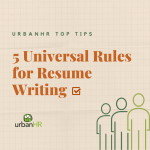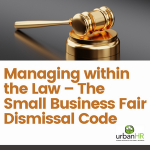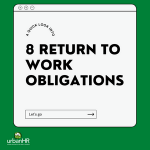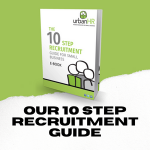
6 Steps to Good Employee Performance Management
Performance management is rarely simple, in fact, it’s becoming increasingly more complex. This 6 Step guide will help you keep on track, and perhaps out of the courtroom!
These steps are adapted from s387 of the Fair Work Act and the Small Business Fair Dismissal Code which deals with Terminating employment. Have a read if you fancy!
1. Invite the employee to a formal meeting
Yes, you have to do this, and you should give them 24 hours notice too.
It’s simply not fair to have a performance or disciplinary discussion that could lead to a formal warning or worse dismissal (and yes I’ve seen it) without notifying the employee in writing of the meeting.
How can someone prepare without knowing what they’re in for?

You need to give people time and advise them of the reason for the meeting.
It can definitely be tricky, and we can be on hand to support you.

2. Allow a support person or a witness
And remember that you are advised to have one too.
This could mean there are 4 people in the room. That’s ok.
It’s only fair to allow the employee to have someone to lean on, give them some support or simply be a witness to what happens.
If you follow these steps you shouldn’t be worried about them having someone present.
You can also have someone as well, and I’d advise that you do.
Having one of our HR Advisors there is a great idea.
3. Stick to the facts & allow the employee to respond
Everyone likes to turn a situation around or find excuses.
Your job is to stick to the facts. Keep emotions off the table.
If someone tries to bring ‘But John is doing it too, why aren’t you talking to him?’ into the situation simply state that you’re not there to talk to John today, this discussion is about you and what you’re doing wrong/not doing etc.
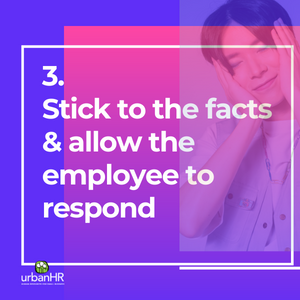
Now, this can get really tricky if you don’t know the facts. If you’re dealing with theft, fraud or another matter of serious misconduct, I’d suggest an impartial investigation is conducted.
Remember that you are there to find out what happened.
Whilst it’s not a court of law you need to consider what the employee has to say in their defence. Their response may not be adequate, such as, ‘I was late for the 100th time because I forgot my lunch’ or ‘I was absent because I was abducted by aliens’ but you need to give them the opportunity to respond before you make a decision.

4. Consider the employee’s response
I couldn’t count the number of times that I’ve heard a manager say ‘give them a first warning’ or ‘this will be their last warning’.
I think to myself, well, it might be but how can you be so sure without having heard the employee’s side of the story.
Never make a decision before the meeting has started. You can even make a decision after the meeting has finished.
Clearly explain to the employee that you and their manager (if you’re the HR person) shall be considering the situation and their response and then making a decision on the outcome over the next 24 hours.
Remember that a decision to dismiss should not be taken lightly and that a court will look at whether a dismissal is harsh, unjust or unreasonable in each case.
5. Documentation is king
Let’s face it, we’ve all been there. There’s a ‘he said – she said’ argument going on and at the end of the day you were going to write the notes down.
Then you put it off till the next day. A week later you really can’t remember who said what about who or in what order.
Take the time that very day to make some notes, even if they’re handwritten.

It will help you make head or tail of the situation later. You’ll also find it’ll help you out if things get formal.
There are also rules about writing the warnings and making it really clear to the employee that future misdemeanours, actions of a similar nature, inconsistencies etc could lead to more disciplinary action ‘up to and including dismissal’.
Specifically the Fair Work Act states that the warning must identify relevant concerns and make it clear that employment is at risk.

6. Allow for an appeal process
I know this sounds like we’re working in the court system but to be honest, you need to allow the employee the right to have their situation heard again, perhaps even by a third party.
Remember though that your selection of that 3rd party needs to take into consideration their position in the company and their impartiality as well as the confidentiality you could expect from them.
As always, should you need some help, please get in touch.


















